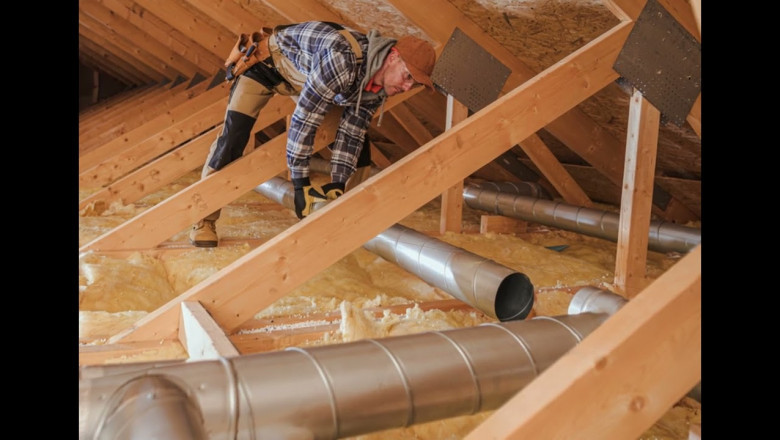views
Why HVAC Insulation Matters
Insulating your home's heating, ventilation, and air conditioning (HVAC) system is one of the most cost-effective ways to improve energy efficiency and comfort. By reducing the escape of cool or warm air through ducts and other components, HVAC insulation helps systems run more efficiently while keeping indoor environments consistently comfortable. Whether upgrading existing insulation or installing it initially, making this investment leads to long-term savings on utility bills as well as environmental benefits.
Types of HVAC Insulation
Different HVAC components require specific insulation materials designed for their usage and conditions. Here are some common insulation types used:
Duct Insulation
HVAC Insulation is the most prevalent duct insulation due to its affordability, durability, and temperature tolerance. In warmer climates, semi-rigid fiberglass boards are popular for air-conditioned ducts whereas flexible fiberglass materials suit heating ducts. Alternative rigid options include foam boards made of polyisocyanurate or polystyrene.
Pipe Insulation
Fiberglass sleeves or pipes wraps provide basic insulation for chilled water, hot water, and steam pipes. Closed-cell foams like elastomeric rubber or flexible polyolefin are vapor barriers that deliver higher R-values for colder or hotter pipes. Pre-slit foam insulation tubes simplify installation around pipes.
Ductboard Insulation
Consisting of a fiberglass core enclosed in laminated foil or kraft paper, ductboard panels create very insulated duct walls ideal for new construction or retrofits. They can attach directly to existing sheet metal ductwork or be installed during fabrication of custom duct systems.
Unit Insulation
Fiberglass batts, loose-fill cellulose or spray polyurethane foams insulate air handler units, heat pumps, condensing units and other HVAC components within protective metal cabinets. The insulation helps maintain consistent internal temperatures and minimizes equipment size requirements.
Benefits of HVAC Insulation
Insulating an HVAC system yields significant financial and performance advantages:
Improved Energy Efficiency
By preventing the loss of conditioned air through ducts and other non-insulated areas, less energy is required to continuously heat or cool air to the desired temperature. This lowers utility bills considerably over the long run.
Increased Comfort
Well-insulated ducts deliver air at the intended temperature to each room instead of experiencing a drop as it travels through uninsulated ductwork. Interior environments feel consistently warm in winter and cool in summer.
Lower Installation and Operating Costs
Insulation allows for downsizing of HVAC equipment since less output is needed to offset air leakage. Smaller units cost less up front and to power. Ductwork fabrication requires less material for insulated rather than bare sheet metal designs.
Extended Equipment Lifespan
Reduced run times from more efficient operation mean mechanical components experience less wear over their lifetime. Properly insulating parts also prevents damage from temperature fluctuations and moisture. HVAC systems last longer before requiring replacement or repairs.
Improved Indoor Air Quality
Insulation helps control condensation that can lead to mold growth inside ductwork. It also limits dust collection and prevents conditioned air from mixing with ambient air in unconditioned spaces like attics and crawlspaces.
How to Insulate an HVAC System
Here are the basic steps to properly insulate the main HVAC components in a home:
1. Inspect all ducts, pipes and equipment cabinets for existing insulation levels and condition. Note any areas requiring new material.
2. Purchase insulation specifically rated for the intended application such as ducts, pipes or unit cabinets. Fiberglass, foam boards and pre-slit pipe wraps are common materials.
3. Clean and prep all surfaces to receive insulation by removing dust or debris. For ducts, ensure seams and joints are securely fastened.
4. Cut insulation to fit snugly around ducts, pipes and cabinet interiors without compression gaps. Overlap seams for complete coverage.
5. Adhere or staple insulation depending on material. Some rigid boards simply press into place while semi-rigid or flexible types require attachment points.
6. For ducts, ensure insulation entirely wraps the outer casing and extends past penetrations through floors, walls and attic boards.
7. Seal and tape insulation edges at any joints, seams or punctures to maintain an airtight barrier. Use insulation compatible sealants as needed.
8. Consider additional vapor barrier treatments for extra protection like duct wrap or mastic compound over insulation on ducts in humid zones.
Proper installation is key to fully capturing the comfort and energy savings potential of insulating an HVAC system. By following manufacturer guidelines, homeowners can enjoy optimized performance for many years to come.
Get this Report in Japanese Language:
Get this Report in Korean Language:
About Author:
Money Singh is a seasoned content writer with over four years of experience in the market research sector. Her expertise spans various industries, including food and beverages, biotechnology, chemical and materials, defense and aerospace, consumer goods, etc. (https://www.linkedin.com/in/money-singh-590844163)






















Comments
0 comment